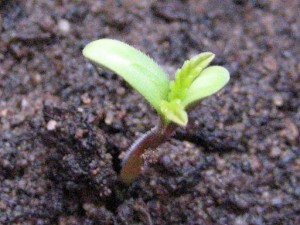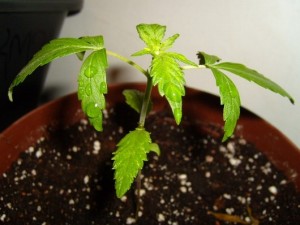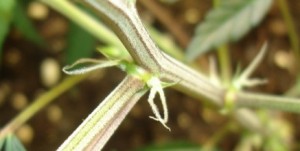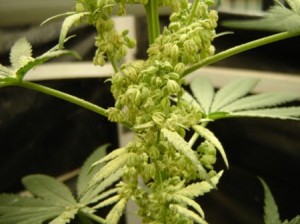Sinsemilla Life Cycle of Cannabis
 Cannabis is a tall, erect, annual cannabis. Provided with an open sunny environment, light well-drained composted soil, and ample irrigation, Cannabiscan grow to a height of 6 meters (about 20 feet) in a 4-6 month growing season. Exposed river banks, meadows, and agricultural lands are ideal habitats for Cannabis since all offer good sunlight. In this example an imported seed from Thailand is grown without pruning and becomes a large female plant. A cross with a cutting from a male plant of Mexican origin results in hybrid seed which is stored for later planting. This example is representative of the outdoor growth of Cannabis in temperate climates.
Cannabis is a tall, erect, annual cannabis. Provided with an open sunny environment, light well-drained composted soil, and ample irrigation, Cannabiscan grow to a height of 6 meters (about 20 feet) in a 4-6 month growing season. Exposed river banks, meadows, and agricultural lands are ideal habitats for Cannabis since all offer good sunlight. In this example an imported seed from Thailand is grown without pruning and becomes a large female plant. A cross with a cutting from a male plant of Mexican origin results in hybrid seed which is stored for later planting. This example is representative of the outdoor growth of Cannabis in temperate climates.
Seeds are planted in the spring and usually germinate in 3 to 7 days. The seedling emerges from the ground by the straightening of the hypocotyl (embryonic stem). The cotyledons (seed leaves) are slightly unequal in size, narrowed to the base and rounded or blunt to the tip. The hypocotyl ranges from 1 to 10 centimeters (1A to 3 inches) in length. About 10 centimeters or less above the cotyledons, the first true leaves arise, a pair of oppositely oriented single leaflets each with a distinct petiole (leaf stem) rotated one-quarter turn from the cotyledons. Subsequent pairs of leaves arise in opposite formation and a variously shaped leaf sequence develops with the second pair of leaves having 3 leaflets, the third 5 and so on up to 11 leaflets. Occasionally the first pair of leaves will have 3 leaflets each rather than 1 and the second pair, 5 leaflets each.
If a plant is not crowded, limbs will grow from small buds (located at the intersection of petioles) along the main stem. Each sinsemilla (seedless drug Cannabis) plant is provided with plenty of room to grow long axial limbs and extensive fine roots to increase floral production. Under favorable conditions Cannabis grows up to 7 centimeters (21A inches) a day in height during the long days of summer.
Cannabis shows a dual response to daylength; during the first two to three months of growth it responds to increasing daylength with more vigorous growth, but in the same season the plant requires shorter days to flower and complete its life cycle.
Life cycle of cannabis I – Juvenile Stage
 Cannabis flowers when exposed to a critical daylength which varies with the strain. Critical daylength applies only to plants which fail to flower under continuous illumination, since those which flower under continuous illumination have no critical daylength. Most strains have an absolute requirement of inductive photoperiods (short days or long nights) to induce fertile flowering and less than this will result in the formation of undifferentiated primordia (unformed flowers) only.
Cannabis flowers when exposed to a critical daylength which varies with the strain. Critical daylength applies only to plants which fail to flower under continuous illumination, since those which flower under continuous illumination have no critical daylength. Most strains have an absolute requirement of inductive photoperiods (short days or long nights) to induce fertile flowering and less than this will result in the formation of undifferentiated primordia (unformed flowers) only.
The time taken to form primordia varies with the length of the inductive photoperiod. Given 10 hours per day of light a strain may only take 10 days to flower, whereas if given 16 hours per day it may take up to 90 days. Inductive photoperiods of less than 8 hours per day do not seem to accelerate primordia formation. Dark (night) cycles must be uninterrupted to induce flowering (see appendix).
Cannabis is a dioecious plant, which means that the male and female flowers develop on separate plants, although monoecious examples with both sexes on one plant are found. The development of branches containing flowering organs varies greatly between males and females: the male flowers hang in long, loose, multi-branched, clustered limbs up to 30 centimeters (12 inches) long, while the female flowers are tightly crowded between small leaves.
Note: Female Cannabis flowers and plants will be referred to as pistillate and male flowers and plants will be referred to as staminate in the remainder of this text. This convention is more accurate and makes examples of complex aberrant sexuality easier to understand.
The first sign of flowering in Cannabis is the appearance of undifferentiated flower primordia along the main stem at the nodes (intersections) of the petiole, behind the stipule (leaf spur). In the prefloral phase, the sexes of Cannabis are indistinguishable except for general trends in shape.
When the primordia first appear they are undifferentiated sexually, but soon the males can be identified by their curved claw shape, soon followed by the differentiation of round pointed flower buds having five radial segments. The females are recognized by the enlargement of a symmetrical tubular calyx (floral sheath). They are easier to recognize at a young age than male primordia. The first female calyxes tend to lack paired pistils (pollen-catching appendages) though initial male flowers often mature and shed viable pollen. In some individuals, especially hybrids, small non-flowering limbs will form at the nodes and are often confused with male primordia.
Cultivators wait until actual flowers form to positively determine the sex of Cannabis
The female plants tend to be shorter and have more branches than the male. Female plants are leafy to the top with many leaves surrounding the flowers, while male plants have fewer leaves near the top with few if any leaves along the extended flowering limbs.
 The term pistil has developed a special meaning with respect to Cannabis which differs slightly from the precise botanical definition. This has come about mainly from the large number of cultivators who have casual knowledge of plant anatomy but an intense interest in the reproduction of Cannabis. The precise definition of pistil refers to the combination of ovary, style and stigma. In the more informal usage, pistil refers to the fused style and stigma. The informal sense is used throughout the book since it has become common practice among Cannabis cultivators.
The term pistil has developed a special meaning with respect to Cannabis which differs slightly from the precise botanical definition. This has come about mainly from the large number of cultivators who have casual knowledge of plant anatomy but an intense interest in the reproduction of Cannabis. The precise definition of pistil refers to the combination of ovary, style and stigma. In the more informal usage, pistil refers to the fused style and stigma. The informal sense is used throughout the book since it has become common practice among Cannabis cultivators.
The female flowers appear as two long white, yellow, or pink pistils protruding from the fold of a very thin membranous calyx. The calyx is covered with resin exuding glandular trichomes (hairs). Pistillate flowers are borne in pairs at the nodes one on each side of the petiole behind the stipule of bracts (reduced leaves) which conceal the flowers. The calyx measures 2 to 6 millimeters in length and is closely applied to, and completely contains, the ovary.
In male flowers, five petals (approximately 5 millimeters, or 3/16 inch, long) make up the calyx and may be yellow, white, or green in color. They hang down, and five stamens (approximately 5 millimeters long) emerge, consisting of slender anthers (pollen sacs), splitting upwards from the tip and suspended on thin filaments. The exterior surface of the staminate calyx is covered with non-glandular trichomes. The pollen grains are nearly spherical slightly yellow, and 25 to 30 microns (p) in diameter. The surface is smooth and exhibits 2 to 4 germ pores.
Before the start of flowering, the phyllotaxy (leaf arrangement) reverses and the number of leaflets per leaf decreases until a small single leaflet appears below each pair of calyxes. The phyllotaxy also changes from decussate (opposite) to alternate (staggered) and usually remains alternate throughout the floral stages regardless of sexual type.
The differences in flowering patterns of male and female plants are expressed in many ways. Soon after dehiscence (pollen shedding) the staminate plant dies, while the pistillate plant may mature up to five months after viable flowers are formed if little or no fertilization occurs. Compared with pistillate plants, staminate plants show a more rapid increase in height and a more rapid decrease in leaf size to the bracts which accompany the flowers. Staminate plants tend to flower up to one month earlier than pistillate plants; however, pistillate plants often differentiate primordia one to two weeks before staminate plants.
Many factors contribute to determining the sexuality of a flowering Cannabisplant. Under average conditions with a normal inductive photoperiod, Cannabiswill bloom and produce approximately equal numbers of pure staminate and pure pistillate plants with a few hermaphrodites (both sexes on the same plant). Under conditions of extreme stress, such as nutrient excess or deficiency, mutilation, and altered light cycles, populations have been shown to depart greatly from the expected one-to-one staminate to pistillate ratio.
Just prior to dehiscence, the pollen nucleus divides to produce a small reproductive cell accompanied by a large vegetative cell, both of which are contained within the mature pollen grain. Germination occurs 15 to 20 minutes after contact with a pistil. As the pollen tube grows the vegetative cell remains in the pollen grain while the generative cell enters the pollen tube and migrates toward the ovule. The generative cell divides into two gametes (sex cells) as it travels the length of the pollen tube.
 Pollination of the pistillate flower results in the loss of the paired pistils and a swelling of the tubular calyx where the ovule is enlarging. The staminate plants die after shedding pollen. After approximately 14 to 35 days the seed is matured and drops from the plant, leaving the dry calyx attached to the stem. This completes the normally 4 to 6 month life cycle, which may take as little as 2 months or as long as 10 months. Fresh seeds approach 100% viability, but this decreases with age.
Pollination of the pistillate flower results in the loss of the paired pistils and a swelling of the tubular calyx where the ovule is enlarging. The staminate plants die after shedding pollen. After approximately 14 to 35 days the seed is matured and drops from the plant, leaving the dry calyx attached to the stem. This completes the normally 4 to 6 month life cycle, which may take as little as 2 months or as long as 10 months. Fresh seeds approach 100% viability, but this decreases with age.
The hard mature seed is partially surrounded by the calyx and is variously patterned in grey, brown, or black. Elongated and slightly compressed, it measures 2 to 6 millimeters (1/16 to 3/16 inch) in length and 2 to 4 millimeters (1/16 to 1/8 inch) in maximum diameter.
Careful closed pollinations of a fewselected limbs yield hundreds of seeds of known parentage, which are removed after they are mature and beginning to fall from the calyxes. The remaining floral clusters are sinsemilla or seedless and continue to mature on the plant. As the unfertilized calyxes swell, the glandular trichomes on the surface grow and secrete aromatic THC-laden resins. The mature, pungent, sticky floral clusters are harvested, dried, and sampled. The preceding simplified life cycle of sinsemilla Cannabis exemplifies the production of valuable seeds without compromising the production of seedless floral clusters.
by R. C. CLARKE
From: weedfarmer.com




